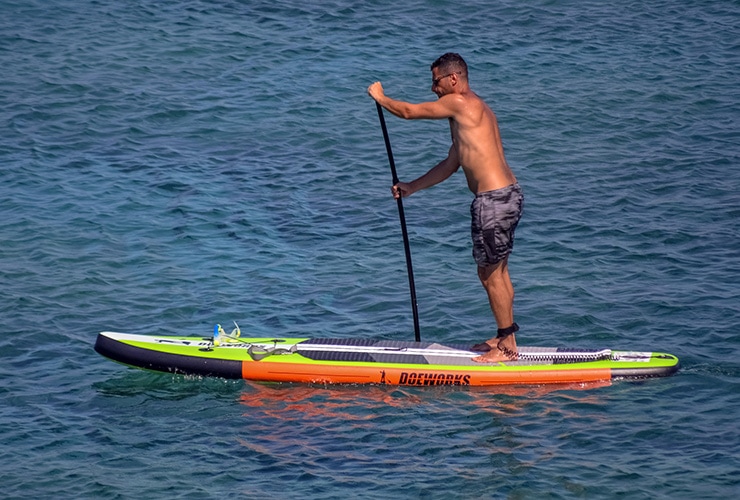In addition to being one of the most enjoyable activities, did you know that SUP is also an amazing workout? Knowing this, you might want to add in a few paddle boarding sessions to your exercise routine.
But what muscles does paddle boarding work?
Stand up paddle boarding is one of the best full-body workouts out there. It works almost every muscle group in your body while being gentle to your joints.
Let’s take a closer look at the muscles used when paddle boarding.
What Muscle Groups Does Stand Up Paddle Boarding Work?
When you paddle properly, you’ll be using your entire body. However, there are certain muscle groups that paddle boarding works out more than others. Let’s take a look at the different muscle groups you’ll be using.
Arm Muscles
This is probably the most obvious one. All your arm muscles play an important role in the paddling process (note that we’re talking about the arm in its entirety – so this includes biceps, triceps, forearms for example).
There are many muscles in both your upper and lower arms. Although you’re advised not to let your arms do all the work while paddle boarding, so as not to tire quickly, they still do a lot.
The lower arm muscles, those in your forearm, help with holding the paddle with your wrist. They’re targeted every time you twist your wrist while making a paddle stroke. They control pretty much every movement you make with your hands and fingers.
The muscles in your upper arms, which include your triceps and biceps, help you straighten your arms at your elbows and bring them towards your body. Paddling involves reaching far forward, planting the blade in the water, and using it to push back through the water, so your paddle board can move forward.
ALSO READ: How to Paddle a Paddle Board – Different Paddle Strokes and Techniques
It’s also important to remember to switch sides too. This means that your lower arm and upper arm muscles, on each arm, can get a serious workout during a paddle boarding session
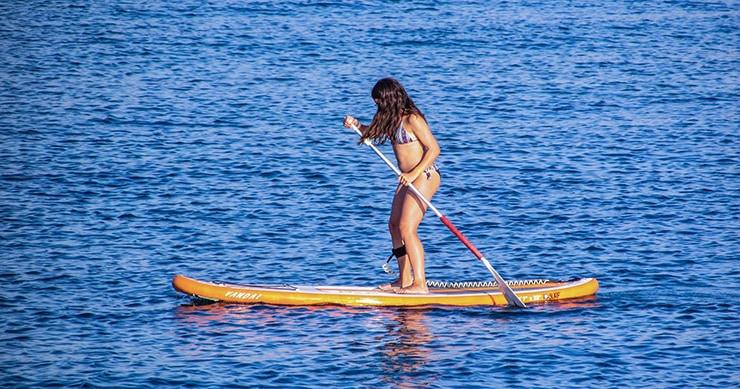
Shoulder Muscles
Paddle boarding also works your shoulder muscles. Without them, you wouldn’t be able to make a single paddle stroke.
The key muscles here are the rotator cuff muscles. These enable you to raise your arms and reach forward to begin your paddle stroke. It’s because of them that your shoulder joints work properly and you get a great range of movement.
Other important shoulder muscles used for paddle boarding include the deltoid muscles, trapezius muscles, and rhomboid muscles. These allow you to lift and lower your shoulder blades as well as move your arms while paddling.
Chest Muscles
The chest muscles are known as the pectoral muscles, and are also important for paddle boarding.
These ones also help with shoulder movements and enable you to freely move your arms across your chest. When paddling on one side, the opposite hand usually has to be across your chest. You wouldn’t be able to do that without the pectoral muscles.
They also work with the rotator cuff muscles to help you rotate your shoulders and move your hands while paddling.
Back Muscles
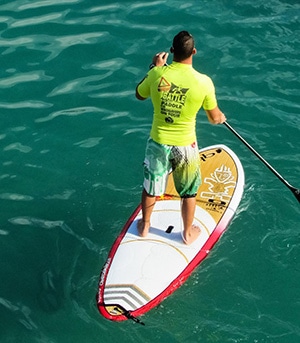
These big muscles are responsible for a lot of movements, including paddle boarding. But only if you do it right.
They allow you to move different parts of your body including your neck, arms, head, shoulders, and even legs. All these parts are key when it comes to stand up paddle boarding.
You use your back muscles every time you stretch your back, bend, twist your torso, and turn your head.
So how does paddle boarding work your back muscles?
To make a proper paddle stroke, you have to bend slightly as you reach forward. You also have to twist your torso slightly towards the paddling side, requiring back strength.
Abdominal Muscles
These are all the muscles in your abdomen–between your pelvis and ribs.
Like the back muscles, your abdominal muscles have many different functions. Some of those include supporting you as you stand, sit, bend, twist, bend, and pretty much everything to do with posture.
They support your core and give you balance.
You’ve heard people say that stand up paddling is a wonderful core workout. They’re not wrong!
Your core muscles help you with balance and posture. A SUP board on water is not exactly the most stable surface, so it challenges your balance a great deal. This means that your abdominal muscles will be engaged the entire time you’ll be paddling.
With every paddle stroke, you have to twist your core slightly so you get power from more than just your arms. Your obliques are responsible for this twisting. They also allow you to turn and switch sides. So there’s no doubt that paddle boarding is a great workout for your core.
Legs and Glutes
Finally, we have the legs and glutes.
Like the core muscles, your glutes also have a part to play in promoting balance. They especially work to ensure the pelvis is balanced. These muscles also help with your posture and make it possible for you to move your thigh muscles.
As for your leg muscles, you need them for any weight-bearing activity, including standing. They help to stabilize your entire body and allow you to flex and move your feet.
Your upper leg muscles make it possible for you to bend and straighten your knees and rotate your hips.
Stand up paddle boarding involves standing, pretty much the entire time. Every single leg muscle will be working to support you and bear the weight of your whole body. You’ll also use these muscles when you rotate your body and move your feet.
Do You Use the Same Muscles When You Paddle While Kneeling?
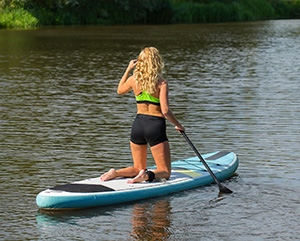
So you can see that when stand up paddle boarding is a whole body workout. But what about kneeling instead of standing?
Some people may prefer to kneel for better balance, especially beginners. Even non-beginners may have to kneel when the wind is too strong, to reduce the resistance.
To some degree, you use the same muscles when you paddle while kneeling. You’ll still need your arm, shoulder, chest, and back muscles to make a proper and powerful stroke. Your core and your upper legs also have to support you and help with balance and turning.
The muscles that you probably won’t use as much are your leg muscles. But every time you flex your feet they will be engaged.
What Muscles Are Used When You’re Prone Paddle Boarding?
Prone paddle boarding is when you lie on your stomach on the SUP and paddle with your arms–the way you do while swimming.
Some paddlers prefer to prone paddle when they’re paddling against a strong wind. It’s also a good way to continue paddling when you have lower body injuries.
While it may not seem like it, paddling in the prone position works a lot of muscles in your body and it’s quite an amazing workout.
You have to keep your head up, which takes a lot of work from your back and shoulder muscles. Paddling using your arms means that your arm muscles will be engaged the entire time. You also need your core and you’ll feel the burn the next day.
SUP Muscle Pain: Causes and Solutions
Stand up paddle boarding can cause soreness or pain. This could be because you haven’t been active or you’re not paddle boarding properly.
Sore Arms
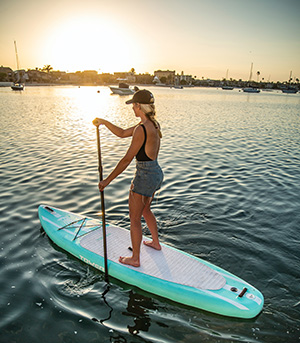
Your arms do a lot of work during paddle boarding. If you haven’t worked out in a while, you might wake up feeling sore the next day. It’s a perfectly normal problem that will go away after a short while. You can get a massage to relieve the tension.
However, the pain could also be caused by the wrong paddling technique where you rely on your arms too much for power. Remember you need to use the bigger muscles in your back and core to avoid overusing your arm muscles. Bend and twist slightly while paddling to activate these big muscles.
Sometimes the pain in your arms can be a little more serious.
Have you heard of paddler’s elbow? It’s elbow tendonitis, common among paddlers. The repetitive paddling movement can cause inflammation in your elbows and even wrists. You may notice pain in your wrist or elbow that gets worse over time–sometimes with swelling.
If this happens, it would be best to see your doctor.
To prevent inflammation in your wrist or elbow, make sure you’re paddling properly and don’t extend your elbows fully. Remember to use the bigger muscles here. Additionally, don’t grip too tightly. Keep your grip light.
Shoulder Pain
This is another common complaint among paddle boarders, especially newbies. Paddling is repetitive which can result in overuse and, consequently, pain in your shoulders.
Always maintain proper paddling form, even when you’re tired. Also, don’t raise your elbow too high while paddle boarding as this can easily lead to a shoulder injury.
The wrong paddle can cause you to hurt your shoulder too. A paddle that’s too long will have you straining and you won’t be able to use the proper paddling technique. Consider having a SUP outfitter help you with your paddle length.
Neck Pain
This can be a problem if you prone paddle board a lot. Keeping your head up while lying down will put pressure on your neck.
Try some warm-up exercises before you start paddling and don’t extend your neck too much. You should also reduce the amount of time you spend prone paddle boarding. If you can’t stand, try kneeling or get a kayak seat.
Painful Feet
Many beginner paddle boarders complain about painful feet and ankles after SUP boarding.
There are two major causes of this pain. The first one is standing in the same position with your legs working to maintain balance and support your body for a long period of time.
The second one is gripping your SUP too hard with your feet. Usually, newbies do this without even realizing it. You only feel the pain later.
Relax your feet and don’t try to grip the paddle board. SUPs have traction pads so you won’t slide off. You can also kneel every once in a while to give your feet and ankles a break.
Does Paddle Boarding Build Muscle?
Stand up paddle boarding targets most of the muscles in your body. It can give you a leaner and more toned appearance.
To help you build muscle, you should consider serious SUP training. You’ll get better results if you’re consistent and include other workouts in your training.
Can You Get Abs from Paddle Boarding?
Yes, provided you have low enough body fat for your abs to be visible, you can get abs from paddle boarding. Serious and consistent paddle boarding can give you more defined abs as it’s a fantastic core workout.
Is Paddle Boarding Hard on Your Back?
No, paddle boarding is not hard on your back–just make sure you’re doing it right. Keep your back relaxed and neutral as opposed to arching or being too tense.
If done correctly, SUP can actually help to alleviate back pain (but you should always consult your doctor before any physical activity if you are in any pain or have experienced injury)
Is Paddle Boarding a Complete Body Workout?
Yes, paddle boarding is a full-body workout that targets multiple muscle groups in your body. You can also vary it by incorporating other activities like SUP yoga or surfing.
Wrapping Up
Stand up paddle boarding is an incredible workout that works most muscles in your body. Your arms won’t be doing all the work!
YOU MAY ALSO LIKE: 12 Fantastic Benefits of SUP Boarding
You’ll be using your arm, shoulder, chest, and back muscles to make a paddle stroke. You need your core, glutes, and leg muscles to support your body as well as to keep you balanced and help you move.
Even some of the tiny muscles that you barely use will all come together to enable you to paddle.

